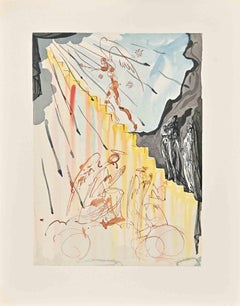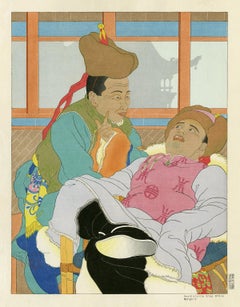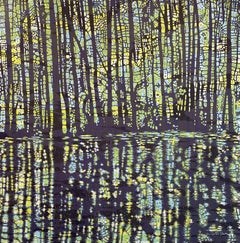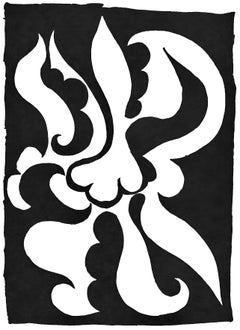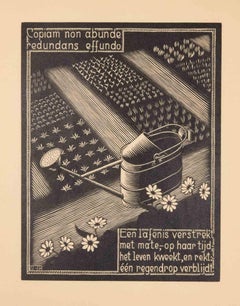Art by Medium: Woodcut
to
1,437
3,593
490
327
181
269
Overall Width
to
Overall Height
to
52
744
3,472
598
30
103
438
309
159
236
400
165
162
120
28
2,427
591
249
214
202
110
57
45
41
25
5
3
1
1
3,418
1,302
117
2,333
1,208
887
841
619
467
458
399
393
366
353
275
241
216
211
183
176
145
132
105
4,867
184,149
97,073
78,340
77,294
170
151
57
50
47
381
2,265
1,894
1,880
Medium: Woodcut
The Celestial Staircase - Woodcut print - 1963
Located in Roma, IT
The Celestial Staircase from the Series "The Divine Comedy" by Dante Alighieri is an woodcut print realized in 1963.
Good conditions. Not signed.
Plate n.21 (as reported on the ba...
Category
1960s Surrealist Art by Medium: Woodcut
Materials
Woodcut
'A Very Funny Story, Mongols' — Mid-Century Woodblock Print
Located in Myrtle Beach, SC
Paul Jacoulet, 'Une Histoire très Drôle, Mongols', color woodblock print, 1949. A fine impression, with fresh colors, on the artist's handmade, personally watermarked Japan paper, in...
Category
1940s Showa Art by Medium: Woodcut
Materials
Woodcut
Beehive - Woodcut by Maurits Cornelis Escher - 1931
Located in Roma, IT
Woodcut print realized by Escher for the series "Emblemata", and published in 1931.
On Hollande van Gelder paper.
Edition of 300.
Unsigned, as issued. Excellent condition, matted....
Category
1930s Modern Art by Medium: Woodcut
Materials
Woodcut
Cove Variation Eight, Trees, Water, Lime Green, Sky Blue, Dark Violet Forest
By Eve Stockton
Located in Kent, CT
This woodcut print on paper evokes the peacefulness of looking across a stream towards a thicket of trees in a forest in shades of light grass green, yellow, sky blue and dark violet...
Category
2010s Contemporary Art by Medium: Woodcut
Materials
Archival Ink, Archival Paper, Monotype, Woodcut
Pablo Picasso, Unitled, from Helen at Archimedes, 1955 (after)
Located in Southampton, NY
This exquisite woodcut after Pablo Picasso (1881–1973) originates from the rare 1955 folio Helene chez Archimede (Helen at Archimedes), illustrations de Pablo Picasso. Published by N...
Category
1950s Cubist Art by Medium: Woodcut
Materials
Woodcut
$1,116 Sale Price
20% Off
Watering Can - Woodcut by Maurits Cornelis Escher - 1931
Located in Roma, IT
Woodcut print realized by Escher for the series "Emblemata", and published in 1931.
On Hollande van Gelder paper.
Edition of 300.
Unsigned, as issued. Excellent condition, matted....
Category
1930s Modern Art by Medium: Woodcut
Materials
Woodcut
Composition - Woodcut by Luigi Spacal - 1970s
Located in Roma, IT
Composition is an original contemporary artwork realized by Luigi Spacal (Trieste, 1907 - Trieste, 2000) in the 1970s.
Original Colored woodcut on cardboard. Image Dimensions: 18 x 14 cm
Good conditions.
Lojze Spacal, also known as Luigi Spacal, was born on the Trieste Karst, at the time of the Austro-Hungarian Empire, from a family of Slovenian nationality.In 1930 he was arrested on charges of anti-fascism and confined for some time to Accettura, in Basilicata. Here he discovered his artistic vocation. In 1934 he graduated in Venice. He began to exhibit his first works in 1937. In 1942 he was again sent to confinement, this time in Abruzzo and, later, assigned to a special working battalion in Forte dei Marmi. Nevertheless, he managed to continue to exhibit his works so much that, in 1944, he set up his first solo show. In 1948 he participated for the first time in the Venice biennial. In 1958 he won the International Grand Prix "for a draftsman and engraver" at the Venice Biennale. In 1959 he received the 2nd prize at the International Biennial of Graphic Art in Ljubljana. In 1974 he was awarded the Prešeren prize, the highest Slovenian artistic recognition, and the “San Giusto d'Oro” in 1977. In 1998 a museum was dedicated to him in the castle of San Daniele...
Category
1970s Abstract Art by Medium: Woodcut
Materials
Woodcut
Sculptor at Work - Woodcut after Takakane Fujiwara - 1950s
Located in Roma, IT
Sculptor at work is an artwork realized in the Early 20th Century after Takakane Fujiwara.
Sheet dimensions: 30 x 19.5 cm.
Reprint.
Good conditions.
Category
1950s Modern Art by Medium: Woodcut
Materials
Paper, Woodcut
David Shrigley - Sorry I Snapped At You - Edition of 30
Located in London, GB
David Shrigley
Sorry I Snapped At You, 2025
Woodcut
53 x 40 cm
Edition of 30
hand-signed and numbered by the artist
published by Shäfer Editions and comes with COA from the publisher...
Category
2010s Contemporary Art by Medium: Woodcut
Materials
Woodcut
$3,214 Sale Price
20% Off
Dance class - Woodcut - Vintage Louvre Museum edition after Edgar DEGAS
By Edgar Degas
Located in Paris, IDF
Edgar DEGAS (after)
Dance class
Woodcut print after a painting of Degas
Egraved by G. Regnier
On vellum 65 x 50 cm (c. 26 x 20in)
Edited by Chalcographie du Louvre, authenticated with the blind stamp of Museum workshop
This woodcut print is very rare as it's no longer printed...
Category
Late 20th Century Realist Art by Medium: Woodcut
Materials
Woodcut
The Sailboat - Original woodcut, Handsigned
Located in Paris, IDF
Edward PELLENS
The Sailboat, 1922
Original woodcut
Handsigned in pencil
Numbered /154
On vellum 32.5 x 25.5 cm (c. 13 x 10 in)
Bears the blind stamp of t...
Category
1920s Art Deco Art by Medium: Woodcut
Materials
Woodcut
Bijinga - Woodcut by Utagawa Toyohiro - Early 19th Century
Located in Roma, IT
Bijinga (New year festivities) is an original modern artwork realized by Utagawa Toyohiro in the Early 19th Century.
Woodcut Print Oban Format
New year festivities, two elegant la...
Category
19th Century Modern Art by Medium: Woodcut
Materials
Paper, Woodcut
Alberto Castro Leñero, ¨Untitled III¨, 2019, Woodcut, 63x31.5 in
Located in Miami, FL
"Alberto Castro Leñero (Mexico, 1951)
'Untitled III', 2020
woodcut on paper Velin Arches 300 g.
62.6 x 31 in. (159 x 78.5 cm.)
Edition of 30
ID: ...
Category
2010s Contemporary Art by Medium: Woodcut
Materials
Paper, Woodcut
Composition (Arntz 148-175; Hagenbach A 25; Bolliger 54), Dreams and Projects
By Jean Arp
Located in Southampton, NY
Woodcut on vélin d’Arches paper. Inscription: Unsigned and unnumbered, as issued. Good condition. Notes: From the folio, Jean Arp, Dreams and Projects, 1951-1952. Published by Curt V...
Category
1950s Modern Art by Medium: Woodcut
Materials
Woodcut
$5,996 Sale Price
20% Off
Annual Events for Young Murasaki (July) - Tales of Genji - Japanese Woodblock
Located in Soquel, CA
Annual Events for Young Murasaki (July) - Tales of Genji - Japanese Woodblock
Rightmost panel a triptych, depicting monthly events for Wakamurasaki (Young Murasaki). This is the month of July. There appears to be a lesson taking place, possibly for writing or poetry.
Artist: Toyokuni III/Kunisada (1786 - 1864)
Publisher: Ebisu-ya Shoshichist
Presented in a new blue mat.
Mat size: 19"H x 13"W
Paper size: 14.5"H x 10"W
Commentary on the triptych:
In the Edo period, Tanabata was designated as one of the five seasonal festivals, and became an annual event for the imperial court, aristocrats, and samurai families, and gradually came to be celebrated by the general public. Its origins are said to be a combination of the Kikoden festival, which originated from the Chinese legend of Altair and the Weaver Girl, and Japan's ancient Tanabata women's faith. Ink is ground with dew that has accumulated on potato leaves, poems and wishes are written on five colored strips of paper, which are then hung on bamboo branches to celebrate the two stars that meet once a year. Although the illustration is a Genji painting...
Category
1850s Realist Art by Medium: Woodcut
Materials
Printer's Ink, Rice Paper, Woodcut
Courtesans at Yoshiwara Edomachi - Figurative Japanese Woodblock Print on Paper
Located in Soquel, CA
Courtesan at Yoshiwara Edomachi - Figurative Japanese Woodblock Print on Paper
Full color woodcut print of two women in elaborate gowns by Utagawa Yoshiiku (Ochiai Yoshiiku) (Japanese, 1833-1904). Two women are dressed in colorful robes with crossed arms. They are underneath a plum blossom tree in bloom, at night. In the background there is a building with many rooms. Valuable polychrome woodblock print of vertical large oban (大判) format made by Utagawa Yoshiiku (歌川芳幾), the famous artist also known as Ochiai Yoshiiku (落合芳幾), and depicting the courtesan Shizuka (しづか), of the house of pleasure Matsumotoro (松本楼), together with her young kamuro (禿) assistant. The couple is escorted by a kanabohiki (金棒引き) watchman holding a lantern and a metal rod with rings to make noise and alert the crowd.
The work, produced in August 1869 by the publisher Tsunajima Kamekichi (綱島亀吉), is taken from the “Twelve Months of Yoshiwara” (よし原十二ヶ月のうち), an elegant series of prints dedicated to the famous red light district of Edo (江戸), and is paired with the “month of leaves” Hazuki (葉月), that is August.
Ochiai Yoshiiku (Japanese, 1833-1904) was an ukiyo-e artist from the end of the Edo Period to the Meiji Period. He has created works which are essential to the history of ukiyo-e, such as“Twenty-eight Famous Murders with Verse”, a series of chimidoro-e (bloody paintings) which Yoshiiku and Tsukioka Yoshitoshi collaborated together, and “Shimbun (newspaper) Nishiki-e” that illustrated Meiji news articles with ukiyo-e.
Born the son of teahouse proprietor Asakusa Tamichi in 1833, Yoshiiku became a student of ukiyo-e artist Utagawa Kuniyoshi toward the end of the 1840s. His earliest known work dates to 1852 when he provided the backgrounds to some actor prints by his master.
Yoshiiku's earliest works were portraits of actors (yakusha-e), beauties (bijin-ga), and warriors (musha-e). He later followed Kuniyoshi into making satirical and humorous pieces, and became the leading name in the field after Kuniyosh's death in 1861. He illustrated the Tokyo Nichi Nichi...
Category
1860s Impressionist Art by Medium: Woodcut
Materials
Paper, Ink, Woodcut
Village of Montmarte, Paris
Located in Belgrade, MT
This piece is part of my private collection since the 1970's. It is an original color lithograph signed and numbered by the Japanese artist Shungo Sekiguchi. In 1935 Shungo Sekiguchi...
Category
Mid-20th Century Modern Art by Medium: Woodcut
Materials
Lithograph, Woodcut
$400 Sale Price
20% Off
"Coyote Scratching His Fleas..." - Woodblock Print
By Daniel Stolpe
Located in Soquel, CA
Vibrant print of a coyote by Daniel Stolpe (American, 1939-2018). Titled, numbered ("Presentation Proof"), signed and dated along bottom edge. Presented in a black frame with a double mat. Sheet on verso with information about the piece, stating that only 5 Presentation Proofs were created, making this piece 1 of 5. Paper size: 24"H x 28"W.
(2018) Master artist and Native Images lithographer Dan "Coyote" Stolpe slipped out of his non-functioning body, and is running free at last and howling in the hills. Born and raised in Los Angeles, Dan's father introduced him to Native American teachers of Art and Culture through the Woodcraft Rangers, who influenced Dan for the rest of his life. "Everything was patterned after a tribal structure," Stolpe said. We learned about Indian life and lore and we had Indian guys teach us how to make Indian costumes and about Indian dance and drums. That's what got me interested."
Dan made his first drum when he was 14, and he was quietly playing that same drum during his final days of life.
Stolpe attended LA Co. Art Institute (OTIS) on scholarship until 1962, when he dropped out to Apprentice with artist Don La Viere Turner in Glendora, and then with Master Printer Joe Funk in Venice until 1966. Commissioned by the Smithsonian Institute, he moved to Washington DC to illustrate extinct birds...
Category
1980s Contemporary Art by Medium: Woodcut
Materials
Ink, Rice Paper, Woodcut
Bougival
Located in Fairlawn, OH
Bougival
Woodcut, 1914
Signed and numbered in pencil
Edition 30, this numberd 22
Printed on laid Van Gelder Zonen paper
Published by Henri Kanweiler, Paris
Printed by Paul Birault, P...
Category
1910s Fauvist Art by Medium: Woodcut
Materials
Woodcut
Bijinga - Woodcut by Utagawa Kunisada - 1830s
Located in Roma, IT
Bijinga is an original artwork realized in 1833-1835 by Utagawa Kunisada (1786-1865).
Chuban. From the series "Tokaido gojusan tsugi no uchi" (The 53 Tokaido Stations). Courtesan i...
Category
1830s Modern Art by Medium: Woodcut
Materials
Woodcut
Actor in Onnagata Role - Woodcut Print by Utagawa Kuniyoshi - 1850s
Located in Roma, IT
Actor in onnagata role accompanied by a kamuro is an original artwork realized in the 1850s by Utagawa Kuniyoshi (January 1, 1798– April 14, 1861).
Woodcut Print.
Sign.: Ichiyusai ...
Category
1850s Modern Art by Medium: Woodcut
Materials
Woodcut
"First Horse Day, 1896" - Chiyoda Palace - Japanese Woodblock by Chikanobu Yoshu
Located in Soquel, CA
"First Horse Day, 1896" - Chiyoda Palace - Japanese Woodblock by Chikanobu Yoshu
Colorful and expressive court scne by Toyohara Chikanobu,"Yoshu" (Japanese, 1838-1912).
This is the r...
Category
1890s French School Art by Medium: Woodcut
Materials
Ink, Rice Paper, Woodcut
Kabuki - Woodcut by Utagawa Kunisada II - 1840
Located in Roma, IT
Kabuki is an original artwork realized in 1864 by Utagawa Kunisada II (1823 1880).
Scene at night in a snowy forest, the actor Ichikawa Kodanji in the ro...
Category
1850s Modern Art by Medium: Woodcut
Materials
Woodcut
Erotic Scene - Woodcut by Mino Maccari - 1945
By Mino Maccari
Located in Roma, IT
Erotic Scene is an original xilography artwork realized by Mino Maccari in 1945. Hand-signed in the pseudonym of "Jean Baschie" which is the artist's signature in 1944-45 ca. erotic ...
Category
1940s Art by Medium: Woodcut
Materials
Woodcut
$306 Sale Price
35% Off
dot pool screen
Located in Columbia, MO
Kristen Martincic earned her BFA from Bowling Green State University and her MFA from the University of Nebraska-Lincoln. The artist, who currently lives and works in Columbia, Misso...
Category
21st Century and Contemporary Contemporary Art by Medium: Woodcut
Materials
Woodcut, Birch, Acrylic
Kiyomizu Temple, Scenes of Famous Places along Tôkaidô Road - Woodblock on Paper
Located in Soquel, CA
Kiyomizu Temple, Scenes of Famous Places along Tôkaidô Road - Woodblock on Paper
Full Title:
Kyoto: Kiyomizu Temple (Kyô Kiyomizudera), from the series Scenes of Famous Places along...
Category
1860s Edo Art by Medium: Woodcut
Materials
Ink, Rice Paper, Woodcut
Hiroshige (1797-1858) - View of Kasumigaseki (Kasumigaseki no zu) 東都名所
Located in BRUCE, ACT
Artist: 広重 Hiroshige (1797-1858)
Series: Famous Places in the Eastern Capital (Tôto meisho) (東都名所)
Title: View of Kasumigaseki (Kasumigaseki no zu) 霞がせきの図
Size: O-ban 大判 24.2 x 36...
Category
1840s Art by Medium: Woodcut
Materials
Woodcut
Clinton Hill, (Vertical Landscape), 1960, woodcut, landscape/abstraction
By Clinton Hill
Located in New York, NY
Clinton Hill (1922-2003), lived in SoHo, New York, and was a frequent Gallery visitor. Born in Idaho and raised on a working ranch, he joined the US Navy during World War II and beca...
Category
Mid-20th Century Abstract Art by Medium: Woodcut
Materials
Woodcut
From Matisse to Hokusai-London Skyscape-Original Mono Screen-British awardArtist
Located in London, GB
This artwork was awarded and Pre-select by Bite , the exhibition, London 2012 , at The Mall Galleries, at the centre of London's famous The Mall, an iconic Avenue, in front of Buckin...
Category
2010s Abstract Expressionist Art by Medium: Woodcut
Materials
Fabric, Dye, Printer's Ink, Monoprint, Woodcut
NIGHT WORK
Located in Portland, ME
Frasconi,Antonio. NIGHT WORK. Color woodcut, 1952. Edition size not stated. Signed, titled, dated, and inscribed P/P (printer's proof) in pencil. 29 x 42 inches (sheet). The print is...
Category
1950s Art by Medium: Woodcut
Materials
Woodcut
'Naked Girl in Spray, Head Thrown Back' — 1930s Modernist Female Nude
By Eric Gill
Located in Myrtle Beach, SC
Eric Gill, 'Naked Girl in Spray, Head Thrown Back to Left, Four Leaves' and 'Naked Girl in Spray, Head Upright, Hands Over Head', wood engraving, 1930, edit...
Category
1930s Art Deco Art by Medium: Woodcut
Materials
Woodcut
$960 Sale Price
20% Off
The Second Tournament with the Tapestry of Samson and the Lion
By Lucas Cranach the Elder
Located in Chicago, IL
Watermark:
Bull's Head with Serpent and Cross (Briquet 1575, dated 1492 by Briquet)
Provenance:
Martin Folkes (Lugt 1034)
Reverend G. L. Blake (Lugt 1172)
Reference:
Bartsc...
Category
18th Century and Earlier Northern Renaissance Art by Medium: Woodcut
Materials
Woodcut
Romantic Drama - Woodcut Print by Utagawa Kunisada - 1850s
Located in Roma, IT
Romantic Drama is an original modern artwork realized by Utagawa Kunisada in 1853.
Woodcut print oban diptych format from a tryptich. Signature: Toyokuni ga. Publisher: Tsujiokaya B...
Category
19th Century Modern Art by Medium: Woodcut
Materials
Woodcut
Maison Typique Doorways
Located in Houston, TX
Delightful French woodcut titled "Maison Typique", 1981. Signed and dated lower right. 66/200
Original artwork on paper displayed on a white mat with...
Category
1980s Art by Medium: Woodcut
Materials
Woodcut
Bird Eggs - Antique egg colour woodblock print, 1875
Located in Melbourne, Victoria
Antique bird egg colour woodblock , 1880, from Francis Orpen Morris’, 'A Natural History of the Nests & Eggs of British Birds', 1875. The woodblocks ...
Category
Late 19th Century Naturalistic Art by Medium: Woodcut
Materials
Woodcut
Bijinga - Woodcut by Utagawa Kunisada - 1844
Located in Roma, IT
Bijinga is an original artwork realized in the half of the 19th Century by Utagawa Kunisada (1786-1865).
From the series "SHyakunin isshu esho" (Girl's pictures and 100 poets' card...
Category
1840s Modern Art by Medium: Woodcut
Materials
Woodcut
(tariff free*) Kandinsky, Motif aus Improvisation N°25, XXe siècle (after)
Located in Southampton, NY
Woodcut on vélin paper. Paper Size: 12.4 x 9.65 inches. Inscription: Unsigned and unnumbered, as issued. Notes: From the album, XXe siècle, Nouvelle série, XXIe Année, N° 13, Noël 19...
Category
1950s Modern Art by Medium: Woodcut
Materials
Woodcut
$796 Sale Price
20% Off
Still Life - Woodcut Print by Domenico Cantatore - Mid-20th Century
Located in Roma, IT
Still Life is a contemporary artwork realized by Domenico Cantatore in the mid-20th Century.
Mixed colored woodcut print. Edition 52/75.
Hand signed by the artist on the lower marg...
Category
Mid-20th Century Modern Art by Medium: Woodcut
Materials
Woodcut
Kabuki Actor - Woodcut by Utagawa Kunisada - 1848/49
Located in Roma, IT
Kabuki Actor is a woodcut print realized by Utagawa Kunisada in 1848/49.
Lifetime impression in very good condition, except for some very minor sign of time.
Category
1840s Modern Art by Medium: Woodcut
Materials
Woodcut
Horizontal 'Spots' II, Minimalist Woodcut Print, 2018
By Damien Hirst
Located in New York, NY
The minimalist's dream, the large-scale iconic contemporary pop art Horizontal 'Spots' with multi-color dots by Damien Hirst is one of fifty-five limited edition woodcut prints on So...
Category
2010s Contemporary Art by Medium: Woodcut
Materials
Woodcut
$60,000 Sale Price
20% Off
Leonard Baskin Abstract Woodcut, Signed
Located in New York, NY
Leonard Baskin (1922-2000)
Untitled, Late 20th Century
Woodcut
Framed: 32 x 24 1/4 x 1/4 in.
Edition 26/50
Signed and numbered lower right
A highly respected draftsman, printmaker, ...
Category
Late 20th Century Abstract Art by Medium: Woodcut
Materials
Woodcut
Retour de la Jungle, Tondano: Celebes (Return from the Jungle, Tondano: Celebes)
Located in San Francisco, CA
This artwork titled " Retour de la Jungle, Tondano: Celebes" (Return from the Jungle, Tondano: Celebes) 1948 is an original color woodcut by French artist Paul Jacoulet, 1896-1960. I...
Category
Mid-20th Century Realist Art by Medium: Woodcut
Materials
Woodcut
Bold Folk Art Lamb Woodcut
Located in Houston, TX
Blocky black and white depiction of a lamb, by German artist Leonhardt Wüllfarth, c.1950. Displayed in a white mat with a gold border and fits a standard-size frame. Archival plastic...
Category
1950s Folk Art Art by Medium: Woodcut
Materials
Paper, Woodcut
Magic Hour, Autumn
By John DePol
Located in Myrtle Beach, SC
John DePol, 'Magic Hour, Autumn', chiaroscuro wood engraving, 1981, edition 160 in 1983. Signed, dated and titled in pencil. Signed in the block, lower right. A superb impression, on...
Category
Mid-20th Century American Modern Art by Medium: Woodcut
Materials
Woodcut
Damien Hirst's Dog, Pictures of Famous Artist's Pets, Damien Hirst Spots Style
Located in Deddington, GB
Damien Hirst’s Dog by Mychael Barratt
Limited edition art print
Handmade Woodcut on paper
Edition of 100
Signed and Titled
Complete size of sheet: 63 ...
Category
2010s Contemporary Art by Medium: Woodcut
Materials
Paper, Woodcut
Libro de Miguel Angel Dieguez - Woodcut by Joaquín Diéguez y Díaz - 1903
Located in Roma, IT
Libro de Miguel Angel Dieguez is a Modern Artwork realized in 1903, by the Spanish Artist Joaquín Diéguez y Díaz.
Coloured woodcut on paper. Hand signed on the back
The work is g...
Category
Early 1900s Symbolist Art by Medium: Woodcut
Materials
Woodcut
Chillida, Composition, Derrière le miroir (after)
Located in Southampton, NY
Woodcut on vélin paper. Inscription: Unsigned and unnumbered, as issued. Good condition. Notes: From Derrière le miroir, N° 174, 1968. Published by Aimé Maeght, Éditeur, Paris; print...
Category
1960s Modern Art by Medium: Woodcut
Materials
Woodcut
$716 Sale Price
20% Off
Teruta-hime - Woodcut by Utagawa Kuniyoshi - 1842/43
Located in Roma, IT
Teruta-hime is a woodcut print realized by Utagawa Kuniyoshi in 1842/43.
Lifetime impression of chuban tate-e, it depicts Teruta-hime carrying a bucket of water through the snow, wi...
Category
Mid-19th Century Modern Art by Medium: Woodcut
Materials
Woodcut
Jacob Pins "Lonely Walker" 1960 Woodcut
By Jacob Pins
Located in San Francisco, CA
Jacob Pins: 1917-2005. Was a German born Israeli woodcut artist and art collector. He has had auction results over $3000 for a print. This powerful scarce example...
Category
1960s Expressionist Art by Medium: Woodcut
Materials
Woodcut
Genji in the Twelve Months - Woodcut by Utagawa Toyokuni III - 1858
Located in Roma, IT
Genji in the Twelve Months / The Tenth Month (Moto) is a tryptich woodcut print realized by Utagawa Toyokuni III in 1858.
Very good condition except for some minor signs of wear.
Category
1850s Modern Art by Medium: Woodcut
Materials
Woodcut
Father Stefan Fridolin, "Schatzbehalter" (Treasury of the True Riches
Located in Fairlawn, OH
Father Stefan Fridolin, "Schatzbehalter" (Treasury of the True Riches of Salvation): The 30th Figure - Astrological Diagram with Scene of the Nativity
Woodcut, 1491
Unsigned, as issued
Published by Anton Koberger
Diagram has Zodiac signs on outer ring, planets in the lower registers, and Nativity in the center.
Condition: Very good for a 15h century woodcut, with the usual slight age stains
Sheet size: 11 1/2 x 8 1/4 inches
Wogelmut was the teacher of Albrecht Durer and employed young Durer in many project of the last decade of the 15th century.
Michel Wolgemut Biography
Wolgemut trained with his father Valentin Wolgemut (who died in 1469 or 1470) and is thought to have been an assistant to Hans Pleydenwurff in Nuremberg. He worked with Gabriel Malesskircher in Munich early in 1471, leaving the city after unsuccessfully suing Malesskircher's daughter for breach of contract, claiming she had broken off their engagement. He then returned to his late father's workshop in Nuremberg, which his mother had maintained since Valentin's death.
In 1472 he married Pleydenwurff's widow and took over his workshop;[3] her son Wilhelm Pleydenwurff worked as an assistant, and from 1491 a partner, to Wolgemut. Some consider Wilhelm a finer artist than Wolgemut, however he died in January 1494, when he was probably still in his thirties. Wilhelm's oeuvre remains unclear, though works in various media have been attributed to him.
Woodcuts
Michael Wolgemut, Danse Macabre, 1493
Two large and copiously illustrated books have woodcuts supplied by Wolgemut and his stepson Wilhelm Pleydenwurff; both were printed and published by Germany's largest publisher, the Nuremberger Anton Koberger, who was also Dürer's godfather. The first is the Schatzbehalter der wahren Reichthumer des Heils (1491); the other is the Historia mundi, by Schedel (1493), usually known as the Nuremberg Chronicle...
Category
15th Century and Earlier Old Masters Art by Medium: Woodcut
Materials
Woodcut
Original Woodcut & Printed Colors of York, Emile Antoine Verpilleux, 1920
Located in New York, NY
Emile Antoine Verpilleux, 1888-1964
York, 1920
Original woodcut, printed in colors
14 x 18 inches
Signed in pencil
Category
1920s Art by Medium: Woodcut
Materials
Woodcut
Almanac E
Located in San Francisco, CA
This Japanese woodblock print is by the noted sosaku hanga artist Hiroyuki Tajima (1911-1984). It measures 24 x 18 inches, (25 x 19.5 inches the sheet, 33.25 x 26.25 inches framed). ...
Category
1960s Abstract Art by Medium: Woodcut
Materials
Woodcut
Polo Players - Woodcut - Mid 20th century
Located in Roma, IT
Polo Players is a print realized by an anonymous in the mid-20th century.
Woodcut print on paper.
Good conditions.
Category
Mid-20th Century Modern Art by Medium: Woodcut
Materials
Woodcut
Thirsty: The Appearance of a Town Geisha - a So-Called Wine-Server - in the Anse
Located in Fairlawn, OH
Thirsty: The Appearance of a Town Geisha - a So-Called Wine-Server - in the Ansei Era
Color woodcut, 1888
Signed; Seal: Taiso (see photo)
Plate 22 from the series "Thirty-two Aspects...
Category
1880s Showa Art by Medium: Woodcut
Materials
Woodcut
The Heretics - Woodcut print - 1963
Located in Roma, IT
The Heretics - Hell plate 10 is a woodcut print realized in 1963 for a series illustrating the Medieval poem of the "Divine Comedy" by Dante Alighieri.
Good conditions.
Limited e...
Category
1960s Surrealist Art by Medium: Woodcut
Materials
Woodcut
$230 Sale Price
35% Off
Sundial - Woodcut by Maurits Cornelis Escher - 1931
Located in Roma, IT
Woodcut print realized by Escher for the series "Emblemata", and published in 1931.
On Hollande van Gelder paper.
Edition of 300.
Unsigned, as issued. Excellent condition, matted....
Category
1930s Modern Art by Medium: Woodcut
Materials
Woodcut
"Encuentro" 2006 Original Unique Signed Artist Proof 28x20in Woodcut Mexican
Located in Miami, FL
Antonio Diaz Cortes (Mexico, 1935)
'Encuentro' (meeting), 2006
woodcut on paper Velin Arches 300 g.
27.6 x 19.7 in. (70 x 50 cm.)
P/A (Artist Proof), unique piece
Unframed
ID: DIA-10...
Category
Early 2000s Contemporary Art by Medium: Woodcut
Materials
Engraving, Woodcut, Ink, Linocut
Tengmalm's Owl - Woodcut Print by Alexander Francis Lydon - 1870
Located in Roma, IT
Tengmalm's Owl is a modern artwork realized in 1870 by the British artist Alexander Francis Lydon (1836-1917).
Woodcut print on ivory-colored paper.
Hand-colored, published by Lond...
Category
1870s Modern Art by Medium: Woodcut
Materials
Woodcut
Courtesan - Woodcut by Keisai Eisen - 1830
By Keisai Eisen
Located in Roma, IT
Courtesan is an original modern artwork realized by Keisai Eisen in the first half of the 19th Century.
Signed and inscribed on plate.
Total dimension...
Category
1830s Modern Art by Medium: Woodcut
Materials
Paper, Woodcut
Woodcut art for sale on 1stDibs.
Find a wide variety of authentic Woodcut art available on 1stDibs. While artists have worked in this medium across a range of time periods, art made with this material during the 21st Century is especially popular. If you’re looking to add art created with this material to introduce a provocative pop of color and texture to an otherwise neutral space in your home, the works available on 1stDibs include elements of orange, yellow, purple, blue and other colors. There are many well-known artists whose body of work includes ceramic sculptures. Popular artists on 1stDibs associated with pieces like this include Mino Maccari, Utagawa Kunisada (Toyokuni III), Eric Gill, and Utagawa Hiroshige. Frequently made by artists working in the Modern, Contemporary, all of these pieces for sale are unique and many will draw the attention of guests in your home. Not every interior allows for large Woodcut art, so small editions measuring 0.04 inches across are also available
